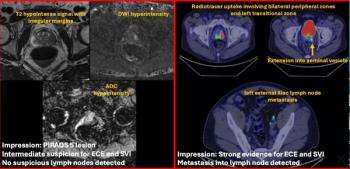
RSNA exhibits feature new issues, products
X-ray image reveals three staples embedded in girl's right hand. Dr. William E. Shiels II, chief of radiology at Nationwide Children's Hospital in Columbus, Ohio, presented data at RSNA meeting showing an alarming trend of self-mutilation among teenagers. Shiels' team has thus far removed 53 objects from nine of 10 patients in their study. In addition to staples, Shiels has seen examples of embedded glass, wood, and bits of crayon.
Siemens' Somatom Definition Flash, formally unveiled at RSNA 2008, captures thorax in 0.6 seconds. With two x-ray tubes and matching detectors, dual-source scanner eliminates need for breath-holding or sedation. During coronary CT angiography, scanner exposes patients to a fraction of the radiation dose of current-generation CT scanners, according to the company. (Provided by Siemens)
Volume Navigation, a feature of GE's new general-purpose Logiq E9 ultrasound system, combines real-time sonography data and MRI data depicting spine of 31- week neonate with meningitis. Color Doppler shows hyperemia in live ultrasound (left) with global perspective provided by MR (right). Such combinedmodality images may help in planning and guidance of interventional procedures, according to the firm. (Provided by GE)
Newsletter
Stay at the forefront of radiology with the Diagnostic Imaging newsletter, delivering the latest news, clinical insights, and imaging advancements for today’s radiologists.




























